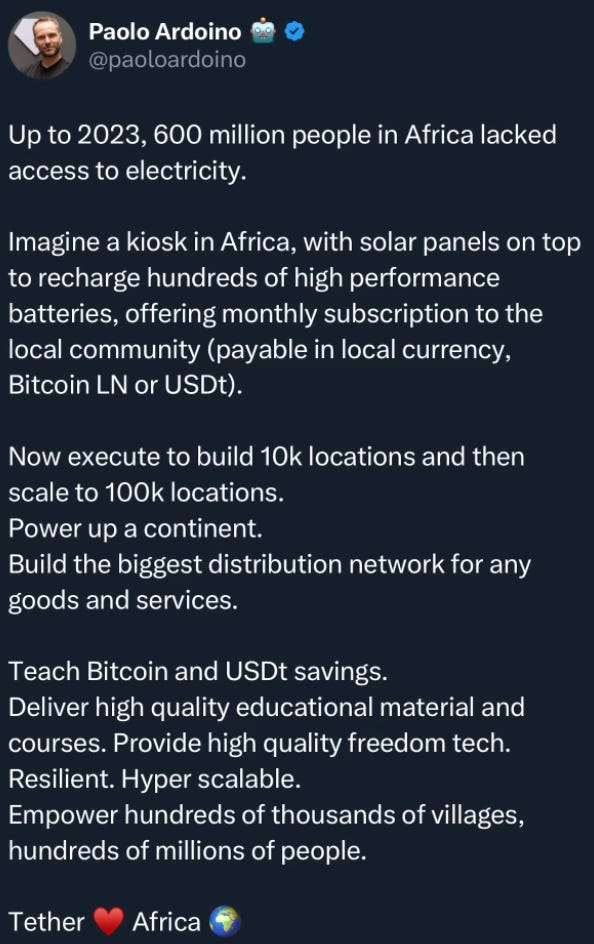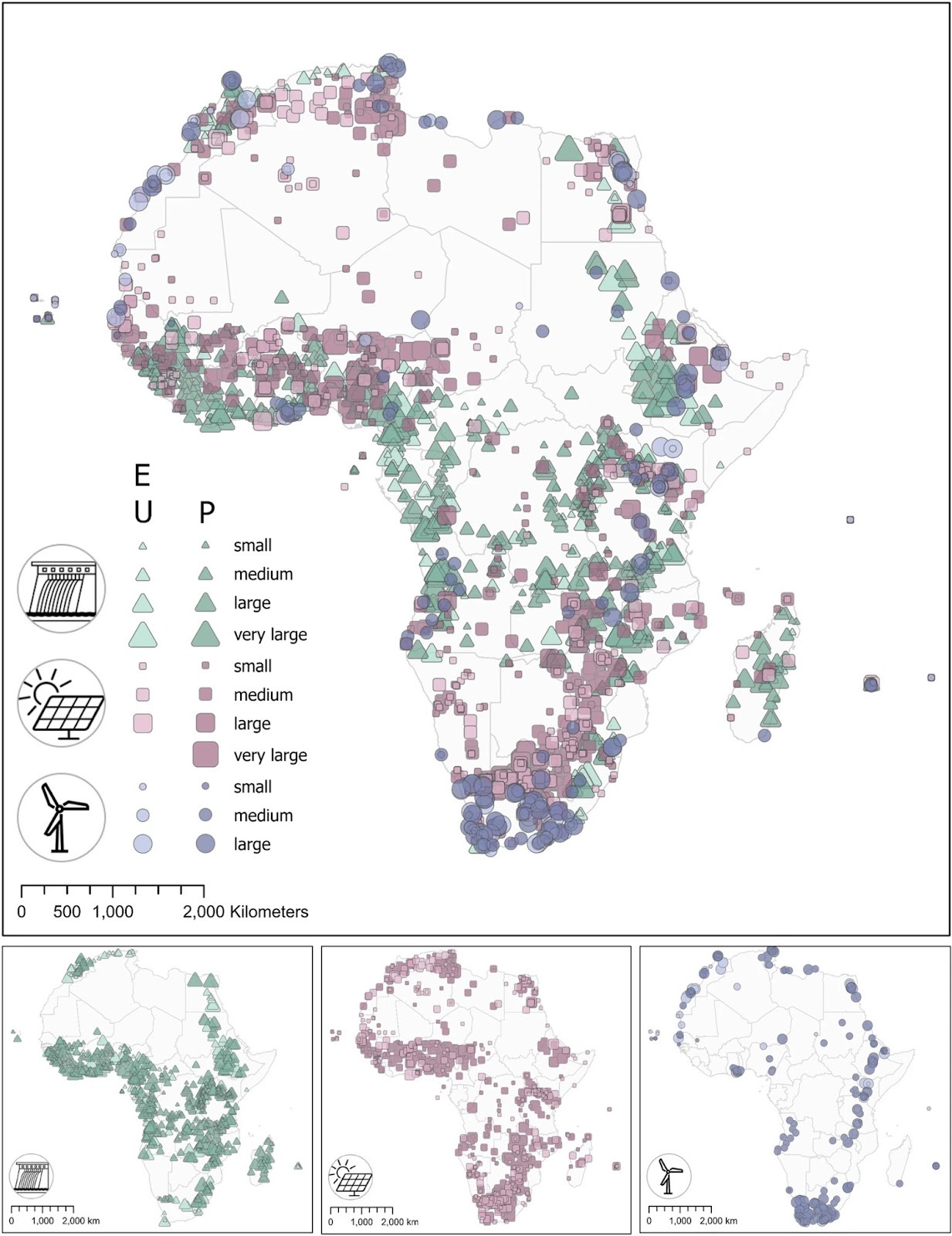Offgrid Africa: Solar Kiosks and Stablecoins
Tether brings a new model to electrifying the continent
Two days ago Tether’s CEO Paolo Ardoino made an announcement on Twitter about their new solar kiosk initiative that has a few hundred solar kiosks already in operation in Africa, where they are offering monthly subscriptions on high performance batteries (payable in USDt and Bitcoin). Their plan is to scale this to 100,000 locations and help power up the continent.
My first take is that this is fantastic, for all the reasons I mentioned in my recent essay on unlocking Africa’s offgrid energy.
This is not a zero-sum game, no single solution will solve the problem of electrifying the African continent. We have 600M people without electricity (83% of the world’s unelectrified population), new models for offgrid energy solutions are the only way forward.
I agree with Paolo that Tether is a once in a century company, after all their profits alone were at $13.7 billion in 2024. And while Tether will continue to see more usage in the US, EU, and China, the developing world is already demanding more USDt as local currencies lose value and people hedge with stablecoins (digital tokens pegged to fiat currencies like the US dollar).
For example, Ethiopia (population 123M) – saw its birr drop ~30% in value in mid-2023 – is now Africa’s fastest-growing stablecoin market, with a 180% year-over-year rise in retail stablecoin transactions.
(note: some assumptions are made on the Tether model, since details are unknown.)
Understanding Africa’s Solar Kiosks
Tether’s initiative in Africa brings together the two worlds of off-grid solar kiosks and stablecoin-based finance. The latter part being the “new” thing. But first we have to understand our history.
I had to do a bit of reading to catch up on things. Across the continent we have seen many solar kiosk companies and NGOs over the last 15 years, so I needed to understand how those had worked (or not worked) and then also do more research on stablecoin usage patterns and metrics in order to have a better educated take on this.
Many kiosk initiatives depend on grants or impact investors and struggle to generate enough revenue to cover costs and grow organically. The ones that I found were:
Solar Kiosk (2011-2019), Ethiopia, Kenya, Botswana, Tanzania, Rwanda, and Ghana had up to 250 kiosks.
ARED “Shiriki Hubs” (ongoing), Uganda and Rwanda, has 60 kiosks.
Community Energy Kiosks (Malawi SOGERV project), Malawi with 4-10 kiosks.
It remains to be defined whether or not Tether is planning a franchise model (likely) or something different. But either way there are some things to highlight right off the bat.
First, by being heavily financed by a for-profit (and VERY profitable) company, this already makes the initiative more likely to succeed. Grant-based financing, especially in a post-USAID Africa, is just not a way to build a scaling enterprise. Even social impact investing can only take you so far before you need real capital partners to deploy a lot of money.
Second, providing a hub for charging batteries hasn’t been enough for the local business owner of the solar kiosk to turn enough of a profit as margins are thin. They need to become actual social hubs in the community, so the successful ones offer WiFi, mobile money, phone charging services, and airtime sales. They do even better when they create a space for a village to watch televised football games at night via solar power.
Tether Solar Kiosk Takeaways:
Tether is set up well here, growth financing is certain, and since the franchise owner is already a mobile money agent they are only adding USDt to their offerings to make the subscription model work. And of course WiFi is a byproduct of the platform that they need to deploy already.
Scaling and logistics in rural Africa’s “last mile” markets is difficult, and there is fierce competition in the off-grid solar sector with the pay-as-you-go financing for home solar already in its thirteenth year… The boneyards are littered with the remains of companies who thought too lightly about competition and logistics in this continent. That’s not to mention theft and vandalism, and of course the need to build trust in this brand in low-trust societies.
Understanding Stablecoins in Africa
In recent years, Africa has emerged as a major growth region for cryptocurrency usage – and stablecoins have become especially popular. Stablecoins now make up a substantial share of Africa’s crypto transaction volume. In fact, as of mid-2024 roughly 43% of all crypto transaction value in Sub-Saharan Africa is from stablecoins, a figure that has surged as people seek refuge from local currency instability. This means stablecoins have even surpassed Bitcoin in popularity for value transfer in the region.
Stablecoins like Tether are not just theoretical assets – they have very practical uses in Africa’s economies today. One major use case is cross-border trade and payments. Small and medium businesses that struggle to get banking access to dollars are turning to stablecoins to pay suppliers abroad or to import goods. A business can convert local money to USDT, send it globally in minutes, and the recipient can cash out in hard currency. This has made stablecoins indispensable for many import-export firms, from food distributors buying stock overseas to merchants sourcing goods from China. Instead of waiting weeks for costly bank transfers (or dealing with black-market forex rates), they use USDT which bypasses traditional intermediaries and high remittance fees.
People don’t care about energy, they care about what electricity can do for them.
People don’t care about WiFi, they care about what they can use it for to improve their lives.
People don’t care about cryptocurrency, they care about what it lets them do.
In Africa, this really matters… What it allows is practical transactions like paying school fees abroad or buying inventory, which would be harder in local currency. This real-world utility has led to U.S. dollar stablecoins like USDt becoming a staple of Africa’s crypto landscape.
We can see why they have done so well. The only real challenge to USDt uptake is found in governments regulators who worry that widespread use could enable capital flight and undermine local currencies. The latter is especially true as no one in their right mind would use the Malawi Kwacha or the Nigerian Naira if they could use USDt across all of their needs both in and out of the country. What we’ve seen thus far is that stablecoins operate in a gray zone: they are widely used informally, but not officially recognized. This creates challenges for large-scale integration – businesses may hesitate to openly transact in USDT if authorities could later penalize it, and fintech startups dealing in stablecoins must often navigate lack of clear licensing frameworks.
Tether Stablecoin Takeaways:
Tether however, has a lot of money, which unlocks a lot of doors in Africa. I think they’ll be fine in most markets that they choose to operate in, and their method to move beyond the heavy urban usage and adoption by traders into the rural areas is a good bet. For obvious reasons the supply chains for those traders going to rural areas can be done in USDt as well as they are done internationally already with their counterparts in China and elsewhere.
Tether’s Solar Kiosk Could Work
The unique twist in Tether’s plan is integrating stablecoin payments and stablecoin services into the kiosk model. This could be a game-changer or a stumbling block. On one hand, stablecoins are already finding grassroots adoption in Africa for the reasons I mentioned above – they address real financial pain points.
By bringing stablecoin usage to a physical kiosk in a rural village, Tether could accelerate financial inclusion: imagine a farmer not only charging his phone at the kiosk, but also converting a portion of his cash earnings into a digital USDt balance that holds value better than the local inflationary currency. He could later use that balance to pay for supplies or receive remittances from a relative abroad in minutes.
In theory, the kiosk becomes both an energy hub and a mini-bank (unofficial) for the underbanked. This integration of energy and fintech could amplify the development impact – providing power and a safer way to save money or transact. No previous solar kiosk project offered such financial services (they were mostly focused on energy and connectivity), so Tether’s idea is innovative in that sense.
Looking at this as a business, it seems like it could be sustainable, and knowing the Tether team, likely profitable. However, I can’t help but think that Tether has a broader strategy which is not purely profit-driven – it’s also about expanding stablecoin adoption and goodwill in emerging markets (especially as regulatory pressures mount in the US/EU, Tether is looking to the Global South for growth). This could mean they are willing to sustain losses on kiosks for some time as they build an ecosystem (much like we saw with Mpesa’s growth in Kenya in the early years).
Figuring out how the Tether model compares and differs to the Gridless Model:
Since my company, Gridless, is the other company bringing a completely new model to financing, building, and making offgrid energy in Africa profitable, I decided to do a comparison of the two.
While Tether plans to deploy solar kiosks across Africa, offering flexible payment options and educational services, we at Gridless take a different path to off-grid electrification. Gridless focuses on building low-cost hydroelectric plants in regions with natural water resources, using excess power to mine Bitcoin as a financial stabilizer.
Financing
The Gridless model uses bitcoin as collateral to finance growth.
The Tether model uses their massive reserves to finance growth.
Energy source
The Gridless model focuses on the low cost and abundance of water with hydroelectricity.
Tether’s model focuses on the low cost and abundance of sunlight with solar.
Revenue streams
The Gridless model uses bitcoin mining and community demand as the monetization engine.
The Tether model uses USDt (or Bitcoin) for payments, and will likely leverage that flow by earning yield on float or encouraging people to use other Tether services.
Growth
Gridless’ model is constrained by geographical requirements for hydro power, yet offers a more localized, resilient energy solution with built-in financial sustainability through Bitcoin mining.
Tether’s model will achieve faster deployment with its financial muscle and standardized kiosks, but it risks cryptocurrency regulatory hurdles and the complexity of managing so many physical sites.
Comparison:
You can see that both models are innovative in combining renewable energy with cryptocurrency, but they serve slightly different niches. Tether's solar kiosks could quickly reach underserved areas, especially where solar is viable but grid expansion is not. Meanwhile, our own Gridless hydroelectric model takes longer to deploy, and provides a more infrastructure-oriented solution, creating durable and reliable power supplies that could better support community growth and development over the long term.
In the ideal scenario, a hybrid approach where solar kiosks fill the gaps in regions where hydro power isn't feasible could maximize the impact of off-grid electrification across Africa.
As you can see, where there is overlap in solar and hydro, there are also vast areas where one is a better fit than the other.
Tether's solar kiosks target sun-rich, grid-poor areas such as the Sahel and the Horn of Africa. These regions, with high solar irradiance and limited hydropower potential, are ideal for modular, quick-to-deploy solar kiosks that provide energy, internet access, and financial services. In contrast, Gridless is focused on building small-scale hydroelectric plants in water-abundant regions like East and Southern Africa, where river flows can support continuous power generation 24/7.
Sources:
Ardoino, Paolo – https://x.com/paoloardoino/status/1896198463722852703
AWIEF - awieforum.org
Solarkiosk Solutions – solarkiosk.eu
Architectural Digest (2019 -: awieforum.org
PV Magazine – pv-magazine.com
Chainalysis – Crypto Adoption in Africa (2024 Report) - chainalysis.com
Cointelegraph – Stablecoin adoption driven by currency woes (2024) - cointelegraph.com
Tether & Yellow Card – tether.io
IMF Blog –imf.org.
LaunchBaseAfrica – Tether deepens African push (2025) - launchbaseafrica.com









